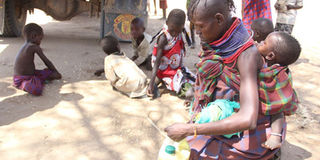Turkana pastoralists embracing irrigation farming to beat perennial hunger

A woman and children ensure no maize grain goes to waste at Chokochok in Turkana Central, Turkana County after a past relief food distribution on January 29, 2014. FILE PHOTO | JARED NYATAYA | NATION MEDIA GROUP
What you need to know:
- According to the Kenya Red Cross communications manager Noella Musundi, about 10,000 families are starving in various parts of the country.
- At least 100,000 farmers in West Pokot and Turkana Counties have invested in crop production following revival of some of the regions’ irrigation schemes.
- Statistics by the National Irrigation Board (NIB) indicate that the country has a potential of more than 600,000 hectares to be put under irrigation but less than
Kenya Red Cross Society has distributed over 96.8 metric tonnes of relief food to thousands of starving Turkana residents as drought ravages the county.
Over 900 families in Kapedo and Napeitom in Turkana East and another 274 others in Lomelo and Nadome sub-locations have benefited from the relief supplies.
According to the Kenya Red Cross communications manager Noella Musundi, about 10,000 families are starving in various parts of the country.
“We are currently distributing relief food to 333 households in Kamuge and Ngilukia sub-locations,” said Ms Musundi.
CHANGE OF TACT
However, some of the pastoralists in the drought hit Kerio Valley region have started to embrace irrigation farming in a move aimed at making the area food secure.
At least 100,000 farmers in West Pokot and Turkana Counties have invested in crop production following revival of some of the regions’ irrigation schemes.
The national and county governments have been challenged by local leaders to allocate sufficient funds for agriculture and for water so as to enable emerging farmers to embrace modern farming techniques.
“The frequent food shortage in semi-arid region can be resolved if pastoralists are motivated to adapt crop production alongside livestock keeping,” said Simon Ewoi Sonko, from Lodwar town.
He called on the Turkana County government to provide farm inputs, seeds and fertiliser to farmers whose crops were destroyed by locusts early this year.
“The attack of the crop by locusts is partly to blame for the current famine facing hundreds of families,” said Mr Ewoi while appealing to the government and humanitarian agencies to hasten distribution of relief supplies.
IRRIGATION SCHEMES
Late last year, three people died of hunger in Nakale ward in Turkana County.
The government and humanitarian agencies have however embarked on revival of irrigation schemes in the region to boost food security.
According to the manager of Turkana Rehabilitation Program (TRP) James Kipkan, change of attitude has enabled most families along Rivers Kerio and Turkwel to turn to cultivation of vegetables, bananas and drought resistant crops like sorghum and millet.
He said TRP in collaboration with World Food Program (WFP) targets to empower about 100,000 farmers with potential to put at least 75,000 acres of land under agricultural use.
Statistics by the National Irrigation Board (NIB) indicate that the country has a potential of more than 600,000 hectares to be put under irrigation but less than 150,000 hectares have been developed, most of which still apply outdated irrigation schemes.
“Inadequate funding is hampering development initiatives in semi-arid areas. There is need for the Government to allocate additional money to enable relevant bodies to start new projects,” appealed Mr Kipkan.
The government under the plan has allocated Sh60 million for irrigation projects in Turkana County.





